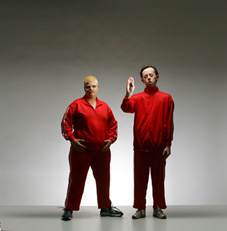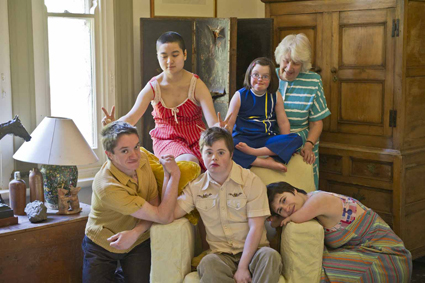 | Sonia Teuben, Simon Laherty, Small Metal Objects photo Jeff Busby |
the disability arts landscape
If we were to read disability arts in Australia as a body, the backbone would clearly be the work of Back to Back Theatre and Restless Dance Theatre, companies whose work demonstrates enduring excellence and global impact. Formed in 1987, Geelong-based Back to Back is Australia’s first professional performing arts company for people with disabilities. Their acclaimed work has toured nationally and internationally making the most significant global impact of the disability arts companies in Australia. Experiments with staging (Food Court), sound (Small Metal Objects), explorations of the audience-performer relationship (Small Metal Objects again) and a remarkable intellectual curiosity (Soft) are some of the hallmarks of Back to Back productions. Thematically, their catalogue features explorations of the body, love, sex, self-perception and space.
 | Next of Kin, Restless Dance Theatre photo Chris Herzfeld |
Other notable contributions to disability arts in Australia include the work of Melbourne's Rawcus and Adelaide-based No Strings Attached, along with the significant presentation of works by other artists and companies at festivals such as Wataboshi, High Beam and Art of Difference, which bring disabled artists together as a community.
finding the words
Disability arts practices often act as a compass that maps radical articulations of humanity. These mappings offer ways of rethinking and feeling cultural spaces of culture typically outside of the mainstream. While these sensory explorations are the work of the largely very accomplished artists, their practices demand other kinds of work for writers and audiences. This is the labour of adequately expressing new sensations in relation to cultural forms and professional practices. Reading the back catalogue of writing about disability and art in RealTime, there are moments where new philosophies of arts practice are articulated in synergistic journalism (RT22; RT53) and inspired intellectual offerings are made in response to live art (RT82). At other points, disability acts as a fault line on which writers stumble and which they conceptually struggle to cross.
In this way, disability and art come together to pose two challenges. The first of these is the call for audiences to feel anew and, in so doing, to brave unique sensations. Dominant tropes of disability representation continue to haunt the work of artists with disabilities, writers and the experiences of disabled people—namely, the freak show (RT62) and disability as other. But these well-worn notions are challenged by the work of many artists (RT22) and writers (RT69) who are able to offer new ways of putting disability politics into print.
The second challenge posed by the union of disability and art is exactly this call for journalists and industry professionals to journey into thought in order to offer words that do some kind of justice to the material cartographies created through enmeshments of disability and art. In his book S/Z, French semiologist and cultural theorist Roland Barthes famously characterised a “writerly text” as one which “is ourselves writing, before the infinite play of the world is traversed, intersected, stopped, plasticized by some singular system (Ideology, Genus, Criticism) which reduces the plurality of entrances, the opening of networks, the infinity of languages” (Paris: Seuil, 1970). For Barthes, reading such work should not be “a parasitical act, the reactive complement of a writing," but rather a “form of work.” In rising to understand the moments in which writers adequately express sensations of disability art in words, it is exactly this form of work in which we, as readers, must learn to engage.
Anna Hickey-Moody